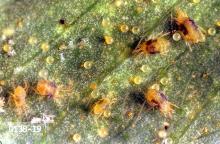Tetranychus spp.
Pest description and crop damage Several species of spider mite are common in the Pacific Northwest. Frequently, infestations include a mixture of spider mite species.
Adult mites are about 0.06 inch in length, have four pair of legs, are greenish to pink or cream color and have various-size black spots on the body. Under warm conditions, spider mites move rapidly within the colony area. Damaged leaves become somewhat stippled on the upper surface and may turn brown or bronze with heavy damage. The undersurface of leaves may have a grayish cast due to webbing. Wilting, leaf deformity, tissue death, and abscission all may take place.
Management-biological control
Spider mite populations are held down in cool conditions early in the season by various predators such as pirate and big-eyed bugs. Predator mites are effective predators of spider mites and are available.
Management-cultural control
Avoid early season applications of insecticides, which will reduce populations of beneficial insects. Spider mite infestations are favored by dry, dusty conditions, so avoid creating these problems and stressing the plants. Excessive nitrogen fertilization may cause population buildup.
Home gardeners: Mites can be hosed from plants with a strong stream of water.
Management-chemical control: HOME USE
- azadirachtin (neem oil)-Some formulations are OMRI-listed for organic use.
- bifenthrin (often as a mix with zeta-cypermethrin).
- horticultural oil-Some formulations are OMRI-listed for organic use.
- insecticidal soap-Apply control measures when mites first appear and repeat application as necessary. Complete coverage, especially under leaves, is essential. Some formulations are OMRI-listed for organic use.
- plant-derived essential oils (such as clove or rosemary)-These have some efficacy against spider mites. Some formulations are OMRI-listed for organic use.
- sulfur (as a mix with pyrethrins)-Some formulations are OMRI-listed for organic use.
Note: Pesticides can injure cucurbits. Be sure foliage is dry at time of application.
Management-chemical control: COMMERCIAL USE
- abamectin (Agri-Mek SC) at 0.009 to 0.019 lb ai/A. PHI 7 days. REI 12 hr. Do not make more than two sequential applications. Retreatment interval 7 days. Do not exceed 0.056 lb ai/A per season.
- bifenazate (Acramite 50W) at 0.375 to 0.5 lb ai/A. PHI 3 days. REI 12 hr. One treatment per season only.
- bifenthrin/zeta-cypermethrin (Hero EW) at 0.1 lb ai/A. PHI 3 days. REI 12 hr. Retreatment interval 7 days. Do not exceed 0.4 lb ai/A per season.
- bifenthrin (Brigade WSB) 0.08 to 0.1 lb ai/A. PHI 3 days. REI 12 hr. Retreatment interval 7 days. Do not exceed 0.3 lb ai/A per season.
- etoxazole (Zeal) at 0.09 to 0.135 lb ai/A. PHI 7 days. REI 12 hr. Do not exceed 1 treatments per season.
- fenpropathrin (Danitol 2.4EC) at 0.2 to 0.3 lb ai/A. PHI 7 days. REI 24 hr. Do not exceed 0.8 lb ai/A per season.
- insecticidal soap (M-Pede) at 2% solution. See label for gal/A. PHI 0 days. REI 12 hr. Some formulations OMRI-listed for organic use.
- lambda-cyhalothrin (Warrior II) at 0.03 lb ai/A (suppression only). PHI 1 day. REI 24 hr. Retreatment interval 5 days. Do not exceed 0.18 lb ai/A per season.
- malathion (Fyfanon 8) at 1 lb ai/A pumpkin and winter squash; 1.75 lb ai/A summer squash. PHI 1 day. REI 12 hr for pumpkins and winter squash and 24 hr for summer squash. Retreatment interval 7 days. Limit 2 treatments pumpkins and 3 treatments squash per year
- naled (Dibrom 8E) at 0.94 to 1.9 lb ai/A. PHI 1 day. REI 48 hr. Retreatment interval 7 days. Limit 5 treatments per year. Do not exceed 5.6 lb ai/A per season. Summer squash only.
- propylene glycol monolaurate (Acaritouch) at 12 to 25 oz/100 gal of formulated product. PHI 1 day. REI 4 hr.
- spiromesifen (Oberon 2SC) at 0.11 to 0.13 lb ai/A PHI 7 days. REI 12 hr. Retreatment interval 7 days. Do not exceed 0.4 lb ai/A per season.
Note: Pesticides may injure cucurbits. The possibility of injury is less when foliage is dry at time of application.
These products contain commonly used active ingredients for control of spider mite in pumpkin and squash. There are other materials available. Please consult a licensed crop advisor for additional recommendations.

